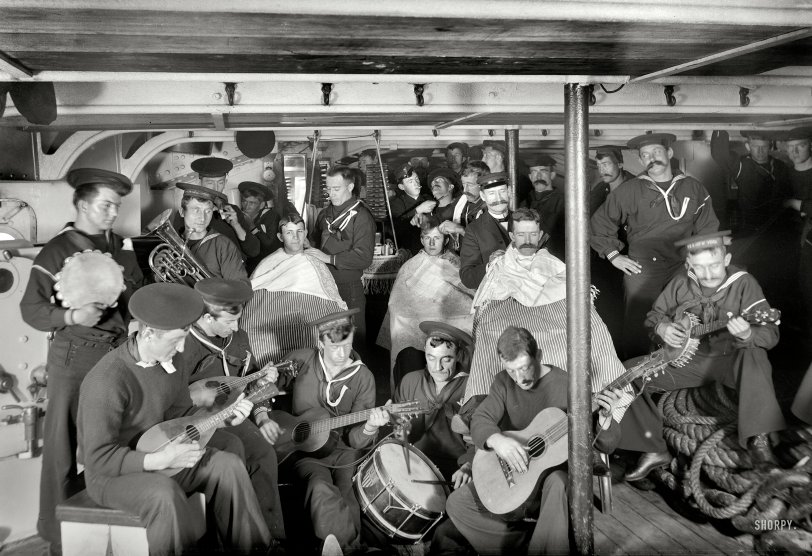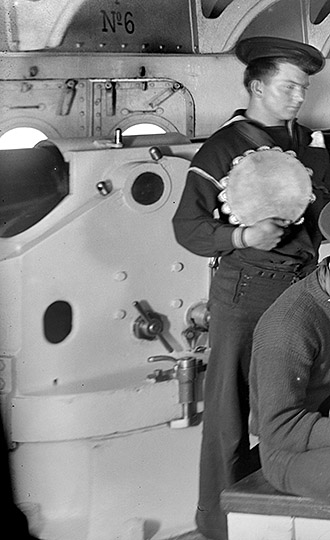


Framed or unframed, desk size to sofa size, printed by us in Arizona and Alabama since 2007. Explore now.
Shorpy is funded by you. Patreon contributors get an ad-free experience.
Learn more.

- Lofty addition
- In 1912
- Keenan Building
- Six years old
- Taken from the P.J. McArdle Roadway?
- It stood only 47 years
- Three track mind
- Incline to the right
- Reach for the sky, 1912 style
- No clean sweep
- Same Job Title, Same Face
- Sadly Lost
- Beautiful ...
- Where you get your kicks
- Aim High
- Pueblo Revival sisters
- Pueblo Neoclassicism
- Milk Man
- Regional dialect.
- Spielberg's inspiration
- Great Photo
- Loaf Story
- Do you still have the Rakes category?
- Could almost be a scene from the 1957 movie 'Hell Drivers'
- The Wages of Fear.
- Conspicuous by their absence
- Got Milk?
- All that aluminum
- No lefties
- Smoke 'em if you've got 'em
Print Emporium
Evening Amusements: 1900

Circa 1900. "U.S.S. New York -- evening amusements." Quite a bit of cutting up here, in one instance almost literally. 8x10 inch dry plate glass negative by Edward Hart, Detroit Publishing Company. View full size.
Blue Nails
I was looking at the blue nails (which look more like bruised than the "blue" described below) imagining the amount of pain of smashing all your fingers not just one like I have experienced in the past... OUCH!
5-string guitar
My guess is it's an intentional 5-string. It looks like the bottom string, normally the thinnest, is strung with a heavy string. This setup would let him tune that single string down low to play bass notes with while strumming rhythm chords with the other four strings above. Bass player and rhythm guitar combined.
Blue Fingernails
Coal Passer or Engineering Division Snipe. Those who worked closely with coal frequently had stained fingernails.
Son of a gun
I suspect that the mechanical-looking object at extreme left is actually a deck gun. Or rather, part of one.
If you look closely you can see a circular object (to the left of the tambourinist), which is probably a trunnion for the gun barrel. The rest of the gun is visible as a horizontal black shiny object partly obscured by said tambourinist and his horn-playing mate.
Update: Very helpful enlargement, Dave! The designation "No 6" indicates this was the sixth gun of its caliber aboard the New York. Since the ship had twelve 4-inch caliber guns (six on each side), it's logical that this was the last gun on one side -- probably the starboard side -- meaning the perspective of the group portrait is looking aft, towards the warship's stern.

Knife Lanyard
The knife lanyard was issued to all sailors (except chief petty officers, officers' messmen, and bandsmen) per the 1897 uniform regulations found here.
They state:
Of bleached white cotton. To be flat sennit, one-half (1/2) to nine-sixteenths (9/16) of an inch wide, tightly laid up; to have a turk's head slide; and to be long enough, when around the neck, to allow the knife to be used with arm extended.

Re: Painted Fingernails
Actually, it's not that uncommon for guitar players to paint their fingernails; the acrylic helped strengthen the nails, although in the long run it's not good for them. I know of several friends who do this now, although I wasn't aware of how far back the tradition went. There is even a clear acrylic solution that music stores sell, specifically for the purpose.
Above water
As Cap'n Jack mentioned, this is well above the water line, as we can see outside reflected in the mirror on the back wall.
Keeping time
I just love this photo - it reminds me of a Brueghel painting. Maybe the things on the white lanyards were pocket watches?
Interesting Mix
Definitely an interesting mix of activities in this photo. We have of course the impromptu band with guitars, drums, banjo and mandolins. Then there's the Tonsorial Parlor - three chairs, no waiting. And finally there's the Marine (based on his cap) with the cigarette apparently about to slit the throat of one of the sailors.
Painted Fingernails or --
possibly a sign of illness.
Blue nails "May be indicative of pulmonary obstruction, emphysema or lung disease"
Physicals probably weren't as thorough back then.
Trivia
In the lower right we can see an anchor chain and a coil of rope (two sizes, at least) carelessly lying on top of it. (The sailor playing the banjo is sitting on the coils). These details suggest we are looking at a location forward and well above the waterline, perhaps on the second deck (maybe called something else in that period).
One detail I've wondered about in many of these turn of the century Navy interior shots: some of the men are wearing a white lanyard-like thing around their necks, with its business end tucked into their front pockets. Could this be a bo's'n's whistle? How many sailors at that time would be equipped with those? If not, what could it be?
The USS New York in the photo (there have been several of the same name both before and after) is an armored cruiser, one of the Navy's biggest and most potent ships of that time. Under three names (New York, Saratoga, and Rochester) she served in the Spanish-American War (seeing action as flagship at the Battle of Santiago) and World War I (being obsolete, she saw little action). Decommissioned in 1933 in the Philippines, she was scuttled in 1941 to prevent capture by the Japanese at the outbreak of World War II.
What am I doing here?
The guy in the back under the hanging alarm clock seems to be pondering. "Should I get a haircut and a shave or should I just grab a tamborine and join these wild and crazy guys?"
5-string guitar
The sailor just right of center evidently broke a string on his guitar (the remnant is visible at the headstock). Maybe it happened just before this photo was taken. His painted fingernails don't look long enough to have caused it.
USS New York LPD-21
Fast forwarding to November 7, 2009, I attended the Commissioning Ceremony for the USS New York where I shot this Panoramic photograph. This is the 7th US Warship to acquire this name and was Commissioned at the Hudson River Pier adjacent to the Intrepid Sea, Air and Space Museum. It is partially made of steel salvaged from the destroyed World Trade Center.

























On Shorpy:
Today’s Top 5